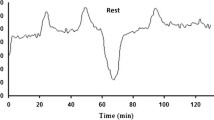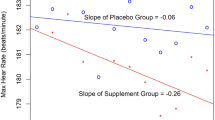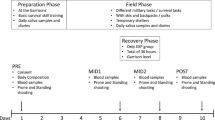Abstract
Purpose
To evaluate the impact of the “Search and rescue” field military training exercise (SR_FTX) on hormonal modulation and identify their possible correlation with physical and cognitive performance.
Methods
An observational (before and after) study was carried out, with male firefighters cadets (n = 42; age = 23[22;27] years) undergoing a nine-day military exercise (SR_FTX). The Countermovement jump (physical performance), the Stroop test (cognitive alertness), and blood tests for testosterone, cortisol, GH, and IGF-1 were applied. Wilcoxon for paired samples and Spearman’s correlation tests were used.
Results
Testosterone (751.10 [559.10;882.8] vs. 108.40 [80.12;156.40] ng/dL) and IGF-1 (217.5 [180;239.30] vs. 105 [93;129] ng/mL) significantly decreased while GH (0.10 [0.06;0.18] vs. 1.10 [0.58;2.28] ng/mL) and cortisol (9.60 [8.20;11.55] vs. 15.55 [12.28;18.98] ug/dL) significantly increased. Physical performance (31.2 [30.04;35.4] vs. 21.49 [19,02;23,59] cm) and cognitive alertness were significantly worse after SR_FTX (Congruent task: 1,78 (0183) vs. 1,56 (0185) response/s and incongruous task: 1,23 (0191) vs. 1,02 (0207) response/s). The physical performance showed a strong correlation with testosterone (rho = 0.694) and regular correlations with both IGF-1 (rho = 0.598) and cortisol (rho = − 0.580). The Stroop test presented weak correlations with GH (rho = − 0.350) and cortisol (rho = − 0.361).
Conclusion
SR_FTX negatively impacted hormonal modulation, physical and cognitive performance. These findings could help commanders decide to replace the employed firefighters in a real mission more frequently. Also, if the real scenario allows, they could think about providing better work conditions, such as improving caloric intake and rest periods, to preserve the military performance and health.






Similar content being viewed by others
Data availability
The datasets generated during and/or analyzed during the current study are available from the corresponding author on reasonable request.
References
Academia de Bombeiro Militar Dom Pedro II (2016) Normas Gerais de Ação do Estágio Básico de Busca Resgate e Sobrevivência. Corpo de Bombeiros Militar do Estado do Rio de Janeiro. Boletim do Comando da ABMDPIInº172
Drain JR, Groeller H, Burley SD, Nindl BC (2017) Hormonal response patterns are differentially influenced by physical conditioning programs during basic military training. J Sci Med Sport 20:98–103. https://doi.org/10.1016/j.jsams.2017.08.020
Nindl BC, Barnes BR, Alemany JA et al (2007) Physiological consequences of US Army ranger training. Med Sci Sports Exerc 39(8):1380–1387. https://doi.org/10.1249/MSS.0b013e318067e2f7
Nelson D L, Cox M M (2014) Princípios de Bioquímica de Lehninger. Artmed, Porto Alegre
Church DD, Gwin JA, Wolfe RR et al (2019) Mitigation of muscle loss in stressed physiology: Military relevance. Nutrients 11(8):1703. https://doi.org/10.3390/nu11081703
Pihlainen K, Kyröläinen H, Santtila M et al (2020) Effects of combined strength and endurance training on body composition, physical fitness, and serum hormones during a 6-Month crisis management operation. J Strength Cond Res. https://doi.org/10.1519/JSC.0000000000003902
Henning PC, Park S, Kim JS (2011) Physiological decrements during sustained military operational stress. Mil Med 176(9):991–997. https://doi.org/10.7205/milmed-d-11-00053
Nindl BC, Rarick KR, Castellani JW et al (2006) Altered secretion of growth hormone and luteinizing hormone after 84 h of sustained physical exertion superimposed on caloric and sleep restriction. J Appl Physiol 100(1):120–128. https://doi.org/10.1152/japplphysiol.01415.2004
Conkright WR, Beckner ME, Sinnott AM et al (2021) Neuromuscular performance and hormonal responses to military operational stress in men and women. J Strength Cond Res 35(5):1296–1305. https://doi.org/10.1519/JSC.0000000000004013
Lieberman HR, Bathalon GP, Falco CM et al (2005) Severe decrements in cognition function and mood induced by sleep loss, heat, dehydration, and undernutrition during simulated combat. Biol Psychiatry 57(4):422–429. https://doi.org/10.1016/j.biopsych.2004.11.014
Hamarsland H, Paulsen G, Solberg PA et al (2018) Depressed physical performance outlasts hormonal disturbances after military training. Med Sci Sports Exerc 50(10):2076–2084. https://doi.org/10.1249/MSS.0000000000001681
Brasil e Silva FB, Vaisman M, Ponce T et al (2022) A systematic review of hormone levels biomarkers of cellular injury and oxidative stress in multi stressor military field training exercises. Arch Endocrinol Metab. https://doi.org/10.20945/2359-3997000000443
Brasil (2011) Tabela de Composição de Alimentos. NEPA/UNICAMP. https://www.nepa.unicamp.br/taco/contar/taco_4_edicao_ampliada_e_revisada.pdf?arquivo=taco_4_versao_ampliada_e_revisada.pdf. Accessed 10 May 2022
Heavens KR, Kenefick RW, Caruso EM et al (2014) Validation of equations used to predict plasma osmolality in a healthy adult cohort. Am J Clin Nutr 100(5):1252–1256. https://doi.org/10.3945/ajcn.114.091009
Holsgaard LA, Caserotti P, Puggaard L, Aagaard P (2007) Reproducibility and relationship of single-joint strength vs multi-joint strength and power in aging individuals. Scand J Med Sci Sports 17(1):43–53. https://doi.org/10.1111/j.1600-0838.2006.00560.x
Balsalobre-Fernández C, Glaister M, Lockey RA (2015) The validity and reliability of an iPhone app for measuring vertical jump performance. J Sports Sci 33(15):1574–1579. https://doi.org/10.1080/02640414.2014.996184
Jackson AS, Pollock ML (1985) Practical assessment of body composition. Physician Sportsmed 13(5):76–90. https://doi.org/10.1080/00913847.1985.11708790
Silva VS, Vieira F (2020) International Society for the Advancement of Kinanthropometry (ISAK) Global: international accreditation scheme of the competent anthropometrist. Rev Bras Cineantropom Desempenho Hum. https://doi.org/10.1590/1980-0037.2020v22e70517
Zimmermann N, Cardoso CO, Trentini CM et al (2015) Brazilian preliminary norms and investigation of age and education effects on the modified Wisconsin card sorting test, stroop color and word test and digit span test in adults. Dement Neuropsychol 9(2):120–127. https://doi.org/10.1590/1980-57642015DN92000006
Callegari-Jacques SM (2003) Bioestatística: Princípios e aplicações. Artmed, Porto Alegre
Ojanen T, Jalanko P, Kyröläinen H (2018) Physical fitness, hormonal, and immunological responses during prolonged military field training. Physiol Rep 6(17):13850. https://doi.org/10.14814/phy2.13850
Henning PC, Scofield DE, Spiering BA et al (2014) Recovery of endocrine and inflammatory mediators following an extended energy deficit. J Clin Endocrinol Metab 99(3):956–964. https://doi.org/10.1210/jc.2013-3046
Thomas DT, Erdman KA, Burke LM (2016) Position of the Academy of nutrition and dietetics, dietitians of Canada, and the American college of sports medicine: nutrition and athletic performance. J Acad Nutri Diet 116(3):501–528. https://doi.org/10.1016/j.jand.2015.12.006
Casazza GA, Tovar AP, Richardson CE et al (2018) Energy availability, macronutrient intake, and nutritional supplementation for improving exercise performance in endurance athletes. Curr Sports Med Rep 17(6):215–223. https://doi.org/10.1249/JSR.0000000000000494
Russell G, Lightman S (2019) The human stress response. Nat Rev Endocrinol 15(9):525–534. https://doi.org/10.1038/s41574-019-0228-0
Nindl BC, Castellani JW, Young AJ et al (2003) Differential responses of IGF-I molecular complexes to military operational field training. J Appl Physiol 95(3):1083–1089. https://doi.org/10.1152/japplphysiol.01148.2002
Friedl KE, Moore RJ, Hoyt RW et al (2000) Endocrine markers of semistarvation in healthy lean men in a multistressor environment. J Appl Physiol 88(5):1820–1830. https://doi.org/10.1152/jappl.2000.88.5.1820
Szivak TK, Lee EC, Saenz C et al (2018) Adrenal stress and physical performance during Military survival training. Aerosp Med Hum Perform 89(2):99–107. https://doi.org/10.3357/AMHP.4831.2018
Vikmoen O, Teien HK, Raustøl M et al (2020) Sex differences in the physiological response to a demanding military field exercise. Scand J Med Sci Sports 30(8):1348–1359. https://doi.org/10.1111/sms.13689
Gomez-Merino D, Drogou C, Chennaoui M et al (2005) Effects of combined stress during intense training on cellular immunity, hormones and respiratory infections. NeuroImmunoModulation 12(3):164–172. https://doi.org/10.1159/000084849
Beckner ME, Main L, Tait JL et al (2022) Circulating biomarkers associated with performance and resilience during military operational stress. Eur J Sport Sci 22(1):72–86. https://doi.org/10.1080/17461391.2021.1962983
Vartanian O, Fraser B, Saunders D et al (2018) Changes in mood, fatigue, sleep, cognitive performance and stress hormones among instructors conducting stressful military captivity survival training. Physiol Behav 194:137–143. https://doi.org/10.1016/j.physbeh.2018.05.008
Booth CK, Probert B, Forbes-Ewan C, Coad RA (2006) Australian army recruits in training display symptoms of overtraining. Mil Med 171(11):1059–1064. https://doi.org/10.7205/milmed.171.11.1059
Lieberman HR, Bathalon GP, Falco CM et al (2005) The fog of war: decrements in cognitive performance and mood associated with combat-like stress. Aviat Space Environ Med 76(7 Suppl):C7–C14 (PMID: 16018323)
Lieberman HR, Farina EK, Caldwell J et al (2016) Cognitive function, stress hormones, heart rate and nutritional status during simulated captivity in military survival training. Physiol Behav 165:86–97. https://doi.org/10.1016/j.physbeh.2016.06.037
Nyberg F, Hallberg M (2013) Growth hormone and cognitive function. Nat Rev Endocrinol 9(6):357–365. https://doi.org/10.1038/nrendo.2013.78
Hickey JP, Donne B, O’Brien D (2012) Effects of an eight week military training program on aerobic indices and psychomotor function. J R Army Med Corps 158(1):41–46. https://doi.org/10.1136/jramc-158-01-11
Acknowledgements
The authors would like to thank all the Commanders of the Dom Pedro II Military Firefighter Academy (Academia de Bombeiro Militar Dom Pedro II—ABMDP II). This work was supported by Fundação Carlos Chagas Filho de Amparo à Pesquisa do Estado do Rio de Janeiro (FAPERJ)–“Pesquisador do Nosso Estado” (Researcher from our state) grant–and also by Conselho Nacional de Pesquisa (CNPq)–“Pesquisador Senior” (Senior researcher) grant and by the Coordination for the impovement of higher education (CAPES) of the ministry of education (MEC)–Brazil 00.889.834/0001-08 and 88882.424876/2019-01.
Funding
This work was supported by Fundação Carlos Chagas Filho de Amparo à Pesquisa do Estado do Rio de Janeiro (FAPERJ)–“Researcher from our state”. Conselho Nacional de Pesquisa (CNPq)–“Senior researcher”. Coordination for the improvement of higher education (CAPES) of the ministry of education (MEC)–Brazil 00.889.834/0001-08 and 88882.424876/2019-01.
Author information
Authors and Affiliations
Contributions
TP, MRMM, TB, VS, MV participated in study design. TP and MRMM wrote the first draft of the manuscript. TP, ELC, TB and MRMM participated in data collection and analysis. All authors participated in manuscript preparation and approved its final version.
Corresponding author
Ethics declarations
Conflict of interest
All authors declared no potential conflicts of interest with respect to the research, authorship, and/or publication of this article.
Research involving human participates and/or animals
This study was performed in line with the principles of the Declaration of Helsinki. Approval was granted by the Ethics Committee of Centro Universitario Augusto Motta (CAAE: 73367317.2.0000.5235).
Informed consent
Informed consent was obtained from all individual participants included in the study.
Additional information
Publisher's Note
Springer Nature remains neutral with regard to jurisdictional claims in published maps and institutional affiliations.
Rights and permissions
Springer Nature or its licensor holds exclusive rights to this article under a publishing agreement with the author(s) or other rightsholder(s); author self-archiving of the accepted manuscript version of this article is solely governed by the terms of such publishing agreement and applicable law.
About this article
Cite this article
Ponce, T., Mainenti, M.R.M., Cardoso, E.L. et al. Military field training exercise with prolonged physical activity and sleep restriction causes hormonal imbalance in firefighter cadets. J Endocrinol Invest 46, 381–391 (2023). https://doi.org/10.1007/s40618-022-01913-4
Received:
Accepted:
Published:
Issue Date:
DOI: https://doi.org/10.1007/s40618-022-01913-4




